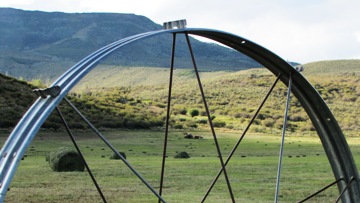Conservation Easement Tax Deduction Extension
By: Amos S. Eno
Posted on:01/04/2011 Updated:01/10/2011An increased tax deduction for conservation not only increases protected land, but increases justice in society.
What do you call a tax code that allows a multimillionaire to deduct the full value of a donated easement worth $500,000, but only allows a working ranch family to deduct one-fifth of its value?
Unfair, unjust, bad for conservation, ridiculous, and unAmerican are a few words that spring to mind.
That, folks, was the law of the land in America throughout 2010 until Congress passed H.R. 4853. The bill extended enhanced easement incentives first written into law in 2006 and renewed again as part of the 2008 Farm Bill but which had expired at the end of 2009. (See a summary of the bill on the Conservation Tax Center website. )
The Enhanced Easement Incentive
The incentive is available to landowners who donate part or all of the value of a conservation easement to a qualified organization exclusively for conservation purposes. Courtesy of the Land Trust Alliance, which has worked tirelessly to pass this tax provision, here’s a summary of what the newly extended tax measure does:
- Raises the income tax deduction a landowner can take for donating a conservation easement from 30% of their adjusted gross income to 50%;
- Allows farmers and ranchers to deduct up to 100% of their adjusted gross income if 50% or more of that income came from farming, ranching or forestry; and
- Increases the time span over which a donor can take deductions from 6 to 16 years.
“One of the mo

st overlooked aspects of this tax provision is its equalizing effect,” says Mitch Butler, a government affairs consultant and lobbyist with
Natural Resource Results LLC. Specializing in natural resources policy with an emphasis on wildlife conservation, Butler sees tax incentives as the primary mechanisms driving private land conservation.
“For example,” he says, “imagine two identical ranches in, say, Wyoming. One is owned by a multimillionaire and another is owned by a fifth-generation ‘land-rich, cash-poor’ ranching family. Each decides to donate the value of a conservation easement worth $500,000. Under the old rules, the millionaire would be able to deduct the full value of his easement the first year. On the other hand, the ranching family with an adjusted gross income of $50,000 per year would only be able to deduct $15,000 in the first year and each subsequent year for five more years.”
Multimillionaire: total $500,000 tax deduction
Ranching family: total $90,000 tax deduction
The value of the donated easement is the same. It’s only the income of the donor that is different.
The newly extended tax provisions - retroactive to the beginning of 2010 and good through the end of 2011 - would allow any landowner to deduct $25,000 per year for 16 years for the same easement donation. That’s a $400,000 deduction. But in this case, the landowners are ranchers. Qualified farmers and ranchers can deduct up to 100% of their adjusted gross income for up to 16 years. That means our fifth generation ranching family will deduct their full adjusted gross income (zero taxes!) for 10 years, until they, too, have deducted the full value of their $500,000 donation.
Incentives Work for Conservation, as Well as FamiliesThe enhanced incentives are also good for the land conservation business. Data collected by the Land Trust Alliance show that “by helping modest income landowners deduct the full value of their contributions, this enhanced tax incentive has increased the pace of private, voluntary land conservation by about 250,000 acres a year nationwide. This is especially important now that the latest reports show that America is losing land to development at the rate of 1.5 million acres per year.”
Butler has served as Deputy Assistant Secretary of the Interior for Fish, Wildlife and Parks and has worked on conservation issues for the White House and former Representative Scott McInnis (R - CO). He says “there is wide, far-reaching bipartisan support for these provisions.
“Most fiscal conservatives recognize that the enhanced deductions are essentially a tax break, which allows landowners to keep more of their own money for delivering a public benefit. In addition, the enhanced deductions serve as an equalizer which allows more landowners to decide the fate of their property, keeping more working lands working and more family farms and ranches in tact.”

Butler’s career in conservation stems from a lifelong passion for hunting and fishing. In fact, prior to moving to Washington, Mitch spent seven years as a fishing guide in Alaska. He tells me, “I’m one of those lucky people who has always known what God put me on the Earth to do: conservation. I work with a number of conservation and sportsmen’s organizations.” Sometimes called a Republican ‘crusader’ for conservation, Mitch works to build diverse, bipartisan coalitions that can “leave their politics at the door” to unite behind common objectives.
Toward Permanent Tax Code Incentives for ConservationMitch continues, “Our focus right now is to make these tax provisions permanent, or at least long-term. This is necessary to create the certainty needed for larger, more complex donations. Conservation buyers and landowners are not likely to invest their time and effort in a complex transaction if the carpet might be pulled out from under them when they arrive at a deal.”
“The broad cross-section of sportsmen, conservation organizations, ranchers and farmers who have coalesced around enhanced incentives is on board with this idea of long-term or permanent change,” continues Mitch. Bipartisan support in the House is strong. “I believe we have a good chance of extending these provisions for five to ten years in the next couple years.”
“The budget climate right now is resulting in reduced conservation funding across the board - from federal and state governments, as well as nonprofits. Yet
people still demand conservation. I believe we’re witnessing a policy shift toward supplementing our conservation expenditures with incentives in other forms, such as tax breaks for private land conservation and stewardship.

“Who knows?” he asks, “After the enhanced easement deduction, we’ll need to maintain our momentum and work for further incentives, perhaps a
conservation tax credit.”
Mitch is one of the lucky few who has always known his life’s mission, but clearly we are lucky to have people like him pursuing these issues.
 Sign In
Sign In
 Sign In
Sign In
